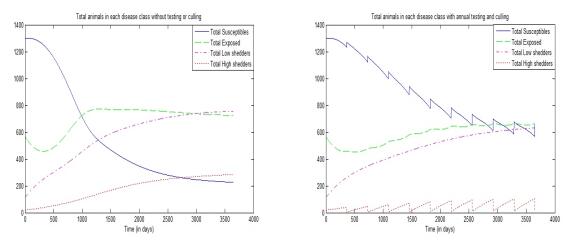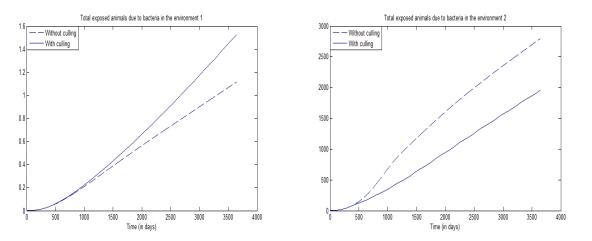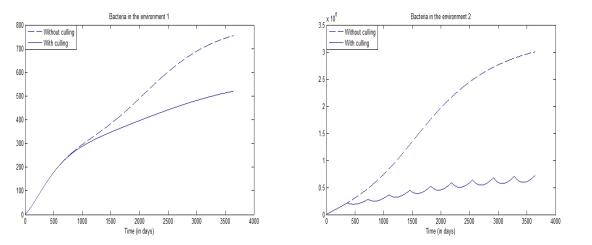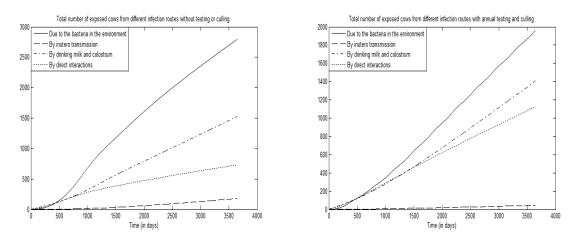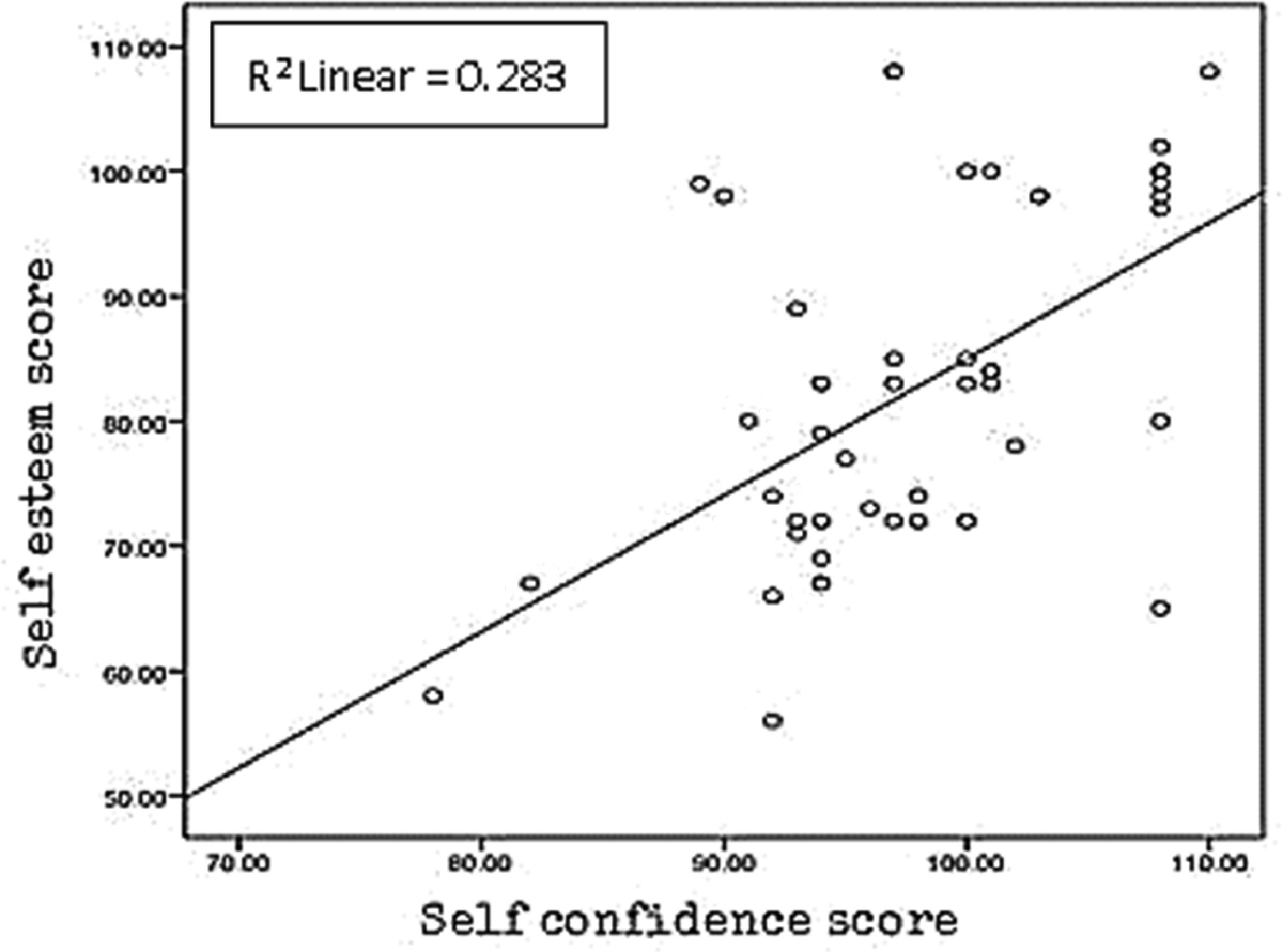1. Introduction
Johne's disease is the clinical manifestation of infection in animals (mostly ruminants) with Mycobacterium avium subspecies paratuberculosis (MAP). It is a chronic inflammatory disease with a long incubation period. It affects the small intestine of ruminants and ultimately leads to the death of the animal. MAP transmits through MAP-contaminated feces, colostrums, milk, water, and soil [6]. Although in utero transmission was also reported [33], the major mode of transmission was reported to be fecal-oral transmission route [6]. Intermittent shedding of MAP into feces occurs at an early stage in MAP-infected animals and continuous higher level of shedding occurs in a portion of the infected animals [20,29]. The outcome of ingestion of MAP-contaminated feces depends on age of the animal and dose of MAP [19,21].
MAP is a slow-growing bacterium and is resistant to extreme temperature. Hence, it can survive outside in the environment for a year or longer [3,32]. But, MAP is a facultative intracellular pathogen and the number of MAP bacilli does not increase in the environment [3].
MAP infection is important to study due to its economic impact on the dairy industry and its possible connection to a human disease, Crohn's disease [26,28,30]. MAP has been estimated to be present in about 68% of US dairy operations [35]. The main problem for the dairy industry is the reduction in milk production and the premature culling of the infected animals. This causes about $250 million annual loss in the productivity of the dairy industry [22].
An important way of controlling MAP infection is through proper management of animals on farms [10]. Although, MAP can be killed by antibiotics, the treatment is not economically feasible to dairy farmers [10]. There are two main ways to diagnosis MAP infection. One is by testing for the bacteria (MAP) and the other is by testing for the antibodies. In the first method of testing, the fecal samples collected from the animals or from the surrounding environment are tested by culturing the bacteria. However, due to the slow growth of MAP these tests could take about two months for the results. Another method of detection of MAP is based on a polymerase chain reaction, which is costly and requires a skilled technician for running the test. In a frequently used test, either blood or milk is tested for the antibodies and the results can be obtained much faster than in MAP detection methods. ELISA (enzyme-linked immunosorbent assays) is an antibody test which is widely used for MAP infection [11]. In 2006, Eda and his colleagues developed a test called EVELISA (ELISA using ethanol extract of MAP) with a much better sensitivity [18,27] than the current ELISA test. Culling the animals with positive test results has been studied to control of MAP infection in dairy farms. In [14], it was shown that with proper farm management, the culling the high-shedding animals can be used to control the disease. Further, it showed that for better results the testing has to be conducted more frequently than once a year to identify and remove high shedders from the farm.
As Johne's disease is a chronic disease with a long incubation period (2-5 years), it is not practical to test different management strategies in actual farms. Mathematical models have therefore been used to predict effectiveness of different control strategies. In a review paper Marcé et al.[15] described eight existing epidemiological models describing the within-herd MAP transmission in dairy farms. Out of those models, four models were discrete-time stochastic models, one was a discrete-time deterministic model and three were continuous-time deterministic models. Some of these models considered horizontal transmission.
But until recently, most models have not considered the MAP transmission through the environment. Humphry et al.[13] considered the ingestion of feces through the environment in their discrete-time stochastic model investigating the dynamics of MAP infection in a suckler-beef herd. In their model, the animals are divided into 4 disease states namely susceptible, subclinical, clinical and resistant. They assumed that the clinically infected animals die within 6 months and further they allow both young and older animals to show clinical signs. The environment was used as a main transmission route in their model. With a 6 months time step in the model, to calculate the probability of infection they considered the bacterial concentration in the environment and the probability of avoiding infection. They assumed that the probability of avoiding infection to be higher for older animals than for younger animals.
In [16], Marcé et al. developed a stochastic model including both the vertical transmission and the horizontal transmission through the ingestion of colostrum, milk or feces in the environment, and they also considered the possibility of calf--to--calf MAP transmission. They studied the dynamics of MAP when no control measures are implemented. For their model they divided the calves into six categories as susceptible, resistant, transiently infectious, latently infected, subclinically infected and clinically infected. They also considered several contaminated environments for each cow category, the environment of the whole farm and the outdoor environment of calves when they graze. They used a model which simulates the population dynamics using specific animal housing arrangements. Further they studied the fadeout and the persistence of the disease starting with small initial conditions for infected animals.
Then, in [17] Marcé et al. studied a closed farm where animals are not purchased from outside to clearly understand the effect of the contact structure of animals within herd on the transmission of MAP. They used the stochastic model developed in [16] and simulated a system without any control in MAP.
In [30], Massaro et al. developed a discrete mathematical model to describe the dynamics of MAP infection in a dairy farm. They have considered the contact structure of the animals in the farm and categorized the animal compartments according to the stage of the disease as well as their age. In their work, they studied the cost effectiveness of EVELISA testing.
Recently, Robins et al. [24] developed an agent-based model to study the dynamics of MAP infection in an dairy farm. They implicitly incorporated the effect of the bacteria in the environment; the direct transmission rate was increased in a location due to the number of high shedders there. Further, they studied the effect of different transmission routes on the prevalence of disease in the system.
Modeling the role of indirect transmission through the environment is an area of current research and modelers are finding it difficult to decide what mechanisms and formats of interaction terms to use. Note that Brehan [2] explained the length of time that a pathogen can survive in the environment would aid in deciding about including such transmission routes and the formats of the interaction terms. Considering the length of time that MAP can survive in the environment, including explicit transmission through MAP in the environment in models seems important, and this is a key component in our paper.
Our goal is to construct a deterministic model to explicitly include compartments for bacteria in different environments and study its effect on transmission of the bacteria among animals in the farm. In studying this effect, we add a novel feature regarding testing. Since testing for MAP usually happens once a year and that is followed by the corresponding culling of infected animals (high shedders) and thenreplacement with susceptible heifers, these culling and replacement actions in the model are implemented as a discrete action at the end of each year. We formulate a system of ordinary differential equations (ODEs) involving progression in this disease and transition in age of the cows on a typical dairy farm. With this system, we are able to show the effects of different transmission routes and management actions on the prevalance. The effects are illustrated with numerical simulations.
The next section gives our model formulation with eleven compartments. Section 3 contains the results of our numerical simulations and discussion of parameters for our model with discrete culling. Our conclusions are presented in the last section.
2. Model formulation
In our study we develop a continuous deterministic model to describe the dynamics of MAP infection in a dairy farm. We analyze the dynamics of prevalence by taking the environmental persistence of the bacteria into account. In this model we use a system of ODEs to describe the behavior of this infection among dairy cows considering the progression of the disease and the age structure of the cows. We categorize the cows into three age groups as 0 -2 months as calves, 2 -24 months as heifers and above 24 months as adults, similar to previous papers [18,24]. The susceptible cows are in three compartments, Sc, Sh, and Sa, corresponding to calves, heifers and adults. Then, we further divide these age categories according to the stage of the disease with exposed compartments (not able to transmit the disease) Ec, Eh, and Ea. Since calves do not usually progress to shedding of MAP, the low-shedding animals are only in compartments Lh and La; the high shedders are only adults, Ha.
Only the female cows are taken into account and male newborn calves would be removed from the dairy farm. In common dairy farm management, the cows are grouped in different locations according to the age and the milk production. Shortly after the birth the calves are moved into individual hutches and the heifers and adults are kept at separate locations. Usually the adult cows can be in four different locations (housing) as pasture, pregnancy pen, lactation barn and maternity barn. But, in our model for simplicity we consider one location for all the adult cows.
We assume that the calves born to susceptible and exposed adults are not infected with MAP at the birth. But, soon after the birth, some calves born to susceptible or exposed adults can be infected with MAP in the adult's environment (direct contact or from MAP in environment). Also, we assume that some calves born to infected adults can be infected in-utero (vertical transmission) and some will born without the infection. Further, the susceptible calves can be infected by MAP contaminated colostrum and milk. Hence, we subdivided the calves into two categories as susceptible and exposed [9]. We did not consider the calves progressing to the shedding stages. Calves are kept in individual hutches and MAP shed into the environment does not contribute to MAP transmission.
As we assume the heifers can only progress in disease to the level of low-shedding [9,25], the heifers are subdivided into three categories as susceptible, exposed and low-shedding. Since, there are low-shedding animals among heifers, the heifer group housing is considered to have bacteria in that environment (called environment 1 in the model). As a result susceptible heifers not only get infected by direct interaction with low-shedding heifers but also by the bacteria in their housing environment.
In the adult category, infected adults can further progress in disease to the level of high-shedding. Thus, the adults were subdivided into four categories as susceptible, exposed, low-shedding and high-shedding. Also, due to the low-shedding and high-shedding adults, their barns were considered to be contaminated with the bacteria (called environment 2 in the model). Hence, the susceptible adults can be infected due to the direct interaction with low-shedding and high-shedding cows and also due to the interaction with the environment. In a dairy system, testing and culling can be used to control this infection [14]. In common management the cows are tested for MAP infection once or twice a year and if the cows are tested positive as a high shedder they are likely removed from the system.
With all the above assumptions and the total amount of MAP in each of the two environments represented by B1 for heifers and B2 for adults, the flow diagram of our model is given in Figure 1. In Figure 1, the horizontal arrows represent the progression in disease stages and the vertical arrows represent the age transitions. The horizontal dashed arrows represent the sources of bacteria to the heifer environment and the adult environment. Further, the curved dashed arrows (pointing upward) indicate that the bacteria in the environments B1 and B2 interact with the susceptible animals. There is no cross-contamination among calf environment, B1 and B2. Our compartments and parameters are listed in Tables 3 and 4, respectively. We assume that the units of time are per day.
We assume the same birth rates for the susceptible, exposed and infected adults. Also, we assume two different vertical transmission rates for low-shedding and high-shedding animals. Further, different death rates are used for each age category and we assume that the culled animals are replaced by susceptible heifers. Also, we use different transmission rates for the calves due to colostrum and milk from low shedders and high shedders. Further, we use different transmission rates for the susceptible heifers with the low-shedding heifers and for the susceptible adults with the low-shedding adults and high-shedding adults. In the two environments, we assume the same decay rate for the bacteria and two different values for the rates at which the bacteria is added to the corresponding environment from low-shedding cows (heifers and adults) and from high-shedding adults. Further, we assumed different values for the probability of getting infected from the bacteria in the environment for calves, heifers, and adults.
In this study our main goal is to analyze the role of the environments in MAP transmission. Using infrequent testing and diagnostic test sensitivity, later we will add these features as a control into our ODE system.
Since the environmental transmission terms are a key part of our model, we now discuss in detail the choice of this transmission function. The bacteria MAP enters the environment mainly from the feces of the shedding cows.To define the transmission due to the bacteria in the environment we need a function with a threshold level before its transition to its maximum level:
|
$
f(B) = \frac{1-e^{-\frac{B}{K_1}}}{1+K_2e^{-\frac{B}{K_1}}} \ .
$
|
(1)
|
In (1), B is the total amount of bacteria taken by an animal per unit time (day). Note that K1 changes the slope and shape and K2 changes the threshold value of the function (where it starts to rise sharply). Using a range of effective doses from $10^3 - 10^{12}$, this function gives the probability of infection, with probability approximately 1 for any $B \geq 10^4$ [1,12]. Ingesting a lower level of MAP may not result in transmission. Hence, we choose $K_1=1000$, and $K_2=100$ so that $f(10000) \simeq 1$ and $f(5000)\simeq 0.5$, since ingesting 10000 MAP bacteria is very likely to result in an infection [12]. The graph of the $f(B)$ function with these values of K1 and K2 is given in Figure 2.
In our model, we take B1 and B2 to represent the total amount of MAP in the heifers environment and the adult environment. Now, that B represents the amount of bacteria taken by an animal, we use a scaling factor C to reflect that the animal consumes only a proportion of bacteria in each environment, using $B = B_i\times C$ in our environmental transmission function (1).
To calculate this proportion of bacteria taken by an animal C, we assume that the bacteria is evenly distributed in the feces and the surrounding environment. Since feces are the main route for MAP to enter and survive in the surrounding environment, the proportion of bacteria taken by an animal per day is approximated by the proportion of the feces taken by an animal per day.
We approximate the amount of new feces entering the environment each day by assuming 800 heifers and 1000 adults in the farm. The low-shedding cows shed less MAP (1-50 MAP/gram of feces)[23] compared to MAP shed by high-shedding cows (100-10,000,000 MAP/gram of feces)[31] We calculate the total amount of new feces in the environment 1 and environment 2 per day as below. On average a cow produces about 29.5 kg of feces per day, which gives, [36]
|
$
Total amount of new feces in the environment 1 per day=800×29.5×106mg.=2.36×1010mgTotal amount of new feces in the environment 2 per day=1000×29.5×106mg=2.95×1010mg.
$
|
We assume that a cow will take about 1 mg of feces per day. Hence the proportion of feces taken by an animal per day for the two environments can be calculated as given below. We approximate the proportion of the feces taken by an animal per day, by the proportion of new feces taken by an animal per day:
For environment 1:
|
$\frac{1}{2.36\times10^{10}} = 4.23\times10^{-11}$
|
For environment 2:
|
$ \frac{1}{2.95\times10^{10}} = 3.39\times10^{-11}$
|
Hence, for simplicity, we find the average of those 2 values and use $C_F=3.8\times10^{-11}$ for both environments. In our numerical simulations we scale B1 and B2 in ten millions ($10^8$). Hence, to adjust for the B1, B2 units in $10^8$, the $C_F$ above becomes $C=0.0038$ in our $f(B_i)$ environmental transmission function.
We describe the dynamics of the system with above assumptions using the following system of ODEs:
|
$dScdt = [b(Sa+Ea)+bLa(1−νL)La+bHa(1−νH)Ha](1−p1−e−B2CK11+K2e−B2CK1)−a1Sc−β1ScLa−β2ScHa−μScScdEcdt = [b(Sa+Ea)+bLa(1−νL)La+bHa(1−νH)Ha]p1−e−B2CK11+K2e−B2CK1+bLaνLLa+bHaνHHa+β1ScLa+β2ScHa−a1Ec−μEcEcdShdt = a1Sc+δHa−γ1ShLh−r1Sh1−e−B1CK11+K2e−B1CK1−a2Sh−μShShdEhdt = a1Ec+γ1ShLh+r1Sh1−e−B1CK11+K2e−B1CK1−a2Eh−d1Eh−μEhEhdLhdt = d1Eh−a2Lh−μLhLhdSadt = a2Sh−γ2SaLa−γ3SaHa−r2Sa1−e−B2CK11+K2e−B2CK1−μSaSadEadt = a2Eh+γ2SaLa+γ3SaHa+r2Sa1−e−B2CK11+K2e−B2CK1−d2Ea−μEaEadLadt = a2Lh+d2Ea−d3La−μLaLadHadt = d3La−μHaHa−δHadB1dt = λ1Lh−μB1B1dB2dt = λ2La+λ3Ha−μB2B2 .
$
|
The birth rates from susceptible, low-shedding and high-shedding adults are represented by b, bLa, and bHa, respectively. The proportions of exposed calves through vertical transmission from low-shedding and high-shedding adults are denoted by $\nu_L$ and $\nu_H$.The $\beta_1 , \beta_2$ terms give the transmission from milk and colostrum from infected cows (low and high-shedding). The death rates are the $\mu_i$ terms, with $\mu_{B_i}$ giving decay of the bacteria. The age progression rates are given by a1, a2, while the disease progression rates are d1, d2, and d3. The shedding of bacteria into the environments are the $\lambda_1, \lambda_2, $ and $\lambda_3$ terms. The direct transmission rates are given by $\gamma_1, \gamma_2,$ and $\gamma_3$. To represent that the calves are more vulnerable to disease than the heifers and adults, the parameters p, r1, r2 representing the probability of getting infected by MAP in the environment for calves, heifers, and adults, respectively, satisfy $p > r_1 = r_2$. Newborn susceptible calves enter the exposed class depending on their contact with the adult environment approximately during their day of birth (term with p). The calves after leaving the adult maternity barn no longer are affected by that environment; thus there are no Sc terms from interactions with the B2 environment. Note that all the parameters are listed in Table 2.
Table 1. Initial number of animals in each compartment.
| Variable | Defining the variable | Initial value |
| Sc | Number of susceptible calves | 130 |
| Sh | Number of susceptible heifers | 520 |
| Sa | Number of susceptible adults | 650 |
| Ec | Number of exposed calves | 70 |
| Eh | Number of exposed heifers | 248 |
| Ea | Number of exposed adults | 250 |
| Lh | Number of low-shedding heifers | 32 |
| La | Number of low-shedding adults | 80 |
| Ha | Number of high-shedding adults | 20 |
| B1 | Amount of bacteria (MAP) in the environment 1(Scaled in 108) | 0.2 |
| B2 | Amount of bacteria (MAP) in the environment 2(Scaled in 108) | 590 |
Table 2. Parameters and their values.
| Parameter | Defining the parameter | Parameter value |
| b | Birth rate of calves from susceptible and exposed adults | 0.00127 |
| bLa | Birth rate of calves from low-shedding adults | 0.00127 |
| bHa | Birth rate of calves from high-shedding adults | 0.00127 |
| µSc | Death rate of susceptible calves | 0.00028 |
| µEc | Death rate of exposed calves | 0.00028 |
| µSh | Death rate of susceptible heifers | 0.000063 |
| µEh | Death rate of exposed heifers | 0.000063 |
| µLh | Death rate of low-shedding heifers | 0.000063 |
| µSa | Death rate of susceptible adults | 0.0012 |
| µEa | Death rate of exposed adults | 0.0012 |
| µLa | Death rate of low-shedding adults | 0.0012 |
| µHa | Death rate of high-shedding adults | 0.0012 |
| µB1 | Decay rate of bacteria in the heifer environment | 0.0027 |
| µB1 | Decay rate of bacteria in the adult environment | 0.0027 |
| δ | Culling rate of high-shedding adults | 0.9 |
| νL | Probability of getting infected through vertical transmission from low-shedding adults | 0 |
| νH | Probability of getting infected through vertical transmission from high-shedding adults | 0.22 |
| a1 | Transfer rate from calves to heifers due to age progression | 0.0168 |
| a2 | Transfer rate from heifers to adults due to age progression | 0.00151 |
| d1 | Transfer rate from exposed heifers to low-shedding heifers | 0.0014 |
| d2 | Transfer rate from exposed adults to low-shedding adults | 0.0014 |
| d3 | Transfer rate from low-shedding adults to high-shedding adults | 0.00078 |
| β1 | Transmission rate for susceptible calves due to the colostrum and milk from low-shedding adults | 0.000021 |
| β2 | Transmission rate for susceptible calves due to the colostrum and milk from high-shedding adults | 0.000028 |
| γ1 | Transmission rate for susceptible heifers due to direct contact with low-shedding heifers | 0.0000024 |
| γ2 | Transmission rate for susceptible adults due to direct contact with low-shedding adults | 0.0000012 |
| γ3 | Transmission rate for susceptible adults due to direct contact with high-shedding adults | 0.0000018 |
| p | Probability of newborn susceptible calves getting infected by MAP in the adult environment | 0.3 |
| r1 | Probability of susceptible heifers getting infected by MAP in the heifer environment | 0.06 |
| r2 | Probability of susceptible adults getting infected by MAP in the adult environment | 0.06 |
| λ1 | Rate at which the bacteria is added to the heifer environment from the low-shedding heifers | 0.007 |
| λ2 | Rate at which the bacteria is added to the adult environment from the low-shedding adults | 0.007 |
| λ3 | Rate at which the bacteria is added to the adult environment from the high-shedding adults | 29.5 |
This model has continuous culling of high-shedding adults, represented in the $\delta$ removal term in the Ha differential equation. Note the corresponding source term in the Sh equation represents the addition of the corresponding number of replacement heifers. Since culling and replacement do not happen continuously on dairy farm, we implement in our numerical simulations a more realistic culling, happening at discrete times.
We use the next generation matrix method [5,4,7,8,34] to analyze the stability of the disease free equilibrium for the model, but an explicit representation for R0 cannot be easily found. We will calculate R0 numerically and present our value after we state the parameter values in the next section.
3. Numerical results
For the numerical simulations, we have used the initial values and parameter values given in Table 1 and 2. With 2000 cows initially, we chose our initial prevalences (see Table 3), as in [24], which was based on local farms. The birth rates, death rates, vertical transmission rates, and disease progression rates were calculated for this ODE system using the parameter values for the discrete system in [24]. The discrete rates in the agent-based model in [24] were converted to rates for ordinary differential equations (continuous time) with time steps being a day. Since the work in [24] did not have explicit environment compartments, we adjusted the transmission rates ($\beta_1, \beta_2, \gamma_1, \gamma_2,$ and $\gamma_3$) so that the rate of prevalence increase becomes similar to our previous report [24]. Parameters related to the environmental transmission were determined on the knowledge of farm practice as described in section 2.
Table 3. Initial prevalence of the disease in each age class.
| Susceptible | Exposed | Low-shedding | High-shedding |
| Calves | 65% | 35% | 0% | 0% |
| Heifers | 65% | 31% | 4% | 0% |
| Adults | 65% | 25% | 8% | 2% |
First to see the dynamics of the disease with no testing or culling we take $\delta = 0$ in the numerical simulations. Next, we take the annual culling rate to be 0.9 in our numerical simulations. Note that we consider the EVELISA test and based on its 90% sensitivity [27] we remove 90% of the high shedding adults by taking annual culling rate to be 0.9 following the annual testing results. We add the corresponding number into the susceptible heifer compartment.
The comparison of the dynamics of the total animals in each class with no testing or culling or with annual testing and corresponding culling is shown in Figure 3. With no testing or culling, the number of susceptible cows decreased and at the end of 10 years there were only 26 susceptible calves (20% of initial number), 176 susceptible heifers (34% of initial number) and 5 susceptible adults (0.8% of initial number) in the system. On the other hand, infected animals increased over time and at the end of 10 years there were 301 low-shedding heifers (841% increase), 456 low-shedding adults (470% increase) and 284 high-shedding adults (1320% increase). With the annual testing and culling, the population seemed to approach an equilibrium. Compared to no tasting and culling graphs in Figure 3, with the annual culling, the number of susceptible adults decreased more slowly and about 90 susceptible adults were left in the system at the end of 10 years. Only 5 susceptible adults remained when no culling was applied. Also, with the annual culling, the number of high shedders was much lower than that in no-culling simulation as expected. The increase in susceptible heifers from the annual replacements can also be seen.
The number of total animals in each disease class with no testing or culling and with annual testing and corresponding culling is compared in Figure 4. Over time, with no testing or culling, the number of total susceptible animals decreased significantly as the total number of infected animals (exposed, low-shedding and high-shedding animals) increased in the system. At the end of 10 years there were only 227 susceptible animals left in the system. There were about 723 exposed animals, 757 low-shedding animals and 284 high-shedding animals. Hence, starting with 35% infected animals, 89% of the animals were infected at the end of the 10 year no-testing or culling simulation. But with annual testing and culling, the rate of decrease in total susceptible animals was lower than that in the no-culling simulation. At the end of 10 years, there were about 662 susceptible animals, 664 exposed animals, 632 low-shedding animals and 10 high-shedding animals. Hence, with the annual testing and culling, about 66% of the total animals were infected with MAP at the end of 10 years. This is about 26% decrease in the total infected animals compared to the no-culling simulation.
The comparison of the dynamics of exposed cows from bacteria in each environment when $p = 0.3 , r_1 = 0.06,$ and $ r_2 = 0.06$ without testing or culling and with annual testing and culling is shown in Figure 5. At the end of 10 years, about 2797 animals were infected due to the bacteria in the environment, with total infected being 5240. Then with annual testing and culling, 1962 animals were infected through bacteria in the environment whereas the number was 2797 in the no-testing simulation
The effect of culling on the numbers in our compartments is given in the Table 4. Just before culling at the end of 10th year there are about 104 high shedders and after culling at the end of the 10th year there are about 10 high shedders left in the system. Hence, with annual testing and culling, the number of susceptible animals increased while the numbers of shedding animals, especially high-shedding adults decreased.
Table 4. Comparison of the number of animals in each compartment at the end of 10 years without culling and with annual culling.
| Compartment | Without culling | With annual testing & culling |
| Sc | 26 | 42 |
| Ec | 53 | 32 |
| Sh | 196 | 530 |
| Eh | 349 | 244 |
| Lh | 301 | 208 |
| Sa | 5 | 90 |
| Ea | 321 | 388 |
| La | 456 | 424 |
| Ha | 284 | 10 |
Figure 6 shows levels of the bacteria in the two environments without and with annual culling. The number of bacteria in environment 2 decreased markedly from about $3\times10^6$ to $7\times10^5$ whereas that in environment 1 (heifer) only slightly decreased. Thus, the annual removal of the 90% of high shedders reduced the total MAP in the adult environment.
In Figure 7, the total number of animals getting infected through different transmission routes are given. From the results in Figure 7 with no testing or culling case, most of the cows are infected through environmental bacteria followed by drinking MAP-contaminated milk/colostrum and the direct interactions. In utero transmission contributed the least among the four transmission routes. This order did not change when annual culling is applied.
Further, with the current initial values, if we run the simulation with no testing and culling for 25 years, we get the final values given in column 2 of Table 5, for each infected class and the bacteria in the two environments. Here we can see that the infected classes approach an endemic equilibrium and at the end of 25 years, about 89% of the total animals are infected. Next, if we use these equilibrium values as new initial conditions for our simulation with annual discrete culling (at 90% of high shedders), the new final values for each infected class and the bacteria in the two environments at the end of 10 years are given in Table 5, column 3. Hence, with testing and culling, the system starting from about 89% prevalence decreases to about 69% at the end of 10 years.
Table 5. Equilibrium values for the number of animals in each compartment at the end of 25 years without culling and the final values for the number of animals in each compartment at the end of 10 years with these equilibrium values as the initial values and annual culling.
| Compartment | Equilibrium values after 25 years without culling | Final values with annual testing & culling |
| Sc | 25 | 40 |
| Ec | 54 | 33 |
| Sh | 184 | 498 |
| Eh | 349 | 252 |
| Lh | 311 | 230 |
| Sa | 4 | 67 |
| Ea | 308 | 370 |
| La | 455 | 439 |
| Ha | 296 | 11 |
| B1 | 807×108 | 610×108 |
| B2 | 3234523×108 | 786526×108 |
Next, using the parameter values in Table 2 and the Disease Free Equilibrium values such that $S_c^*+S_h^*+S_a^* = 2000$, we calculate R0 corresponding to our model. With no culling ($\delta = 0$),
and with continuous culling ($\delta = 0.004$),
Note that the continuous culling rate of $\delta =0.004$ corresponds to about 90% culling in the discrete annual case. If one takes a continuous culling rate of $\delta=0.1$, then R0 is 1.46. Hence, annual testing and culling can reduce the disease progression in the system, but it is difficult to bring R0 below 1 with only culling of high shedders. This may be due to the low shedders continuing to contribute to transmission. With the removal of the high shedders, the infection can still persist in the system, which indicates a need for other interventions. We only showed numerical results for discrete annual culling since that is the usual practice on dairy farms.
4. Conclusions
This work represents the transmission from the environment by using a realistic approximation of bacteria in feces in a farm pasture and barn. The simulations include testing and culling using pulse actions which correspond to actual farm practices.
We calculated the basic reproduction number (R0) for our model using the parameter values. We showed that R0 > 1 and thus the disease free equilibrim is unstable, even with a high level of removal of high-shedding animals from the system. Thus, other management actions besides culling of high shedders are needed to effectively manage this infection. In the future, how to detect and manage low shedders would be important to investigate.
Numerical simulations were run for the model with environmental compartments and annual culling action. Some of the parameters were calculated from the available data and literature and some were determined through knowledge of farm practices. From the numerical simulation results we can conclude that the bacteria in the environment is an important route for MAP transmission. We have analyzed and recorded the effect of discrete (annual) culling on the prevalence in our simulations.
Further modeling and simulation work should be done to see the effect of cleaning of the environment on the prevalence of MAP infection in a farm. Also, we plan to investigate the effect of testing and culling two or three times a year on reducing the prevalence in the system.










 DownLoad:
DownLoad: 

